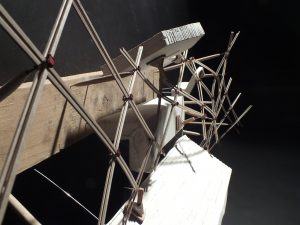For me Architecture has captured my imagination in the power that it holds over our everyday lives in many different ways.
The ability to translate a drawing into something physical and meaningful, for me has always held great fascination. I have attempted to translate these in to my University work, proposing a scheme that is not only sympathetic within its surroundings but acts in response to the current social conditions of the village.
Can you tell us about your final year project?
It is centred around my concern for the way in which our society is progressing in terms of its consumerist nature. In the village of Rottingdean where my site is located I explored the village’s view of historical importance and a prioritisation of consumption of image over protection of history and heritage. For a village that is all about the stereotypical village green, botanical gardens and pretty properties lined by picket fences, they seemed not to know about their history, merely that they were preserving its image as a ‘nice’ aesthetic.
With further investigation, I found that this consumerist way of life stretched further than Rottingdean’s image and into their consumption of food and other aspects. I evaluated that this was predominantly down to the introduction of a consumerist lifestyle and the way that the current Architectural fabric allows this consumerism to flourish, through movement control, architectural blockades, segregation and spatial condition.
I summised that since the arrival of large profit driven companies such as Tesco Express there has been an overwhelming transformation in the views and the lifestyle of the community as the local businesses have begun to go out of business and convenience is proving all too appealing.
My project Re: Co-op++ has been proposed as a response to the current problems around Rottingdean’s community becoming isolated from one another as well as external communities.
Re: Co-op++ tackles this through its architectural form, positioning and programme. To start with it is located on the site of Tesco Express, and so getting rid of it is the act of retaliation to consumerism by demolishing what I see as the root of most of their problems. Tesco’s is positioned along what I have identified as Rottingdean’s façade, which currently seems to be a purposeful deterrent in its solidity, lack of access and signage, something that Rottingdean is fully aware of. The design breaks up the existing harsh building line that is being used enabling enticing people to freely transition into the village and vice-versa.
How have you found studying Architecture at Brighton?
Brighton University has been a great help for me in terms of allowing space to develop my own though processes. The tutors and fellow students all create a great atmosphere where you feel comfortable expressing your opinions and allowing for your work to follow suit. Although my plan is to work in practice after University either in Brighton or London, there is no pressure to follow a career in Architecture, and the way in which it is taught prioritises creative and meaningful thinking through drawing and projects, which is a transferable skill into many other professions.






